Bronze Age - Sold - Photo gallery
Image database with photographs of ancient art and antiquities
Our image database provides photographs of ancient art and antiquities for press releases as well as for private use. All artefacts sold in our gallery are documented through professional photographs. The resulting image library contains numerous ancient Egyptian, Greek and Roman antiquities as well as ancient coins. The time span from Stone Age, over Bronze Age and Classical Antiquity until Late Antiquity is covered.The photo gallery aims at providing a vast visual archive equipped with filters and search tools. You are most welcome to search the constantly growing number of artefacts in the image library. We are also happy to authorize hyperlinks from your webpage / forum to the objects depicted in our gallery. For this purpose, please send us a short notification prior to placing a hyperlink. For almost every object high definition photographs are available and can be provided e.g. to document your collection or for scientific papers or popular science articles. If you are interested in using pictures for publications, print media or other purposes, please contact us and we will be happy to assist you.
-
 Marc Antony legionary Denarius from Wishanger hoard
Marc Antony legionary Denarius from Wishanger hoardFound 2021 in East Hampshire, UK. The hoard is a very impressive proof of the fact that coins were in circulation for up to several centuries in the Roman era.
Price: on request Small Roman Terra Sigillata bowl with potters' mark from the Rhineland
Small Roman Terra Sigillata bowl with potters' mark from the RhinelandFound near the Roman city of Novaesium, today's Neuss in Germany, an early Roman foundation and with this one of the oldest cities in Germany.
Price: on request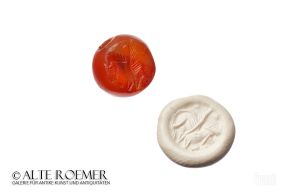 Sasanian stamp seal with winged horse
Sasanian stamp seal with winged horseDark orange Carnelian with engraved schematic depiction of the mythical creature. From the period of Sasanian rule in the Near East.
Price: on request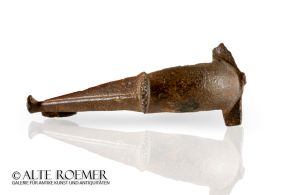 Brooch from Roman Britain
Brooch from Roman BritainThis rare variant of the T-shaped brooches was found in Lechlade, Gloucestershire. It dates to the 1st or 2nd century AR. From the famous Hattatt collection and published in two standard works for ancient fibulae.
Price: on request Dolphin brooch from Roman Britain
Dolphin brooch from Roman BritainThe so-called dolphin brooch is very British. This specimen was probably made by the Celtic Corieltauvi tribe, shortly after the arrival of the Romans in the middle of the 1st century. Published in two works by Richard Hattatt.
Price: on request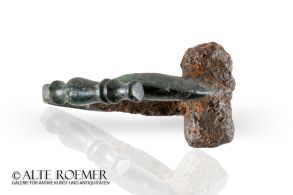 Celtic brooch from Iberia
Celtic brooch from IberiaThe early Celtic brooch dates from the 6th century BC and was found in Spain. This specimen is published in two standard works on ancient brooches.
Price: on request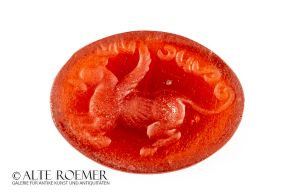 Sassanian intaglio with griffin
Sassanian intaglio with griffinPerfectly preserved ring stone made of orange carnelian. It shows a winged hybrid creature with the body of a lion. With inscription in Pahlavi, the Middle Persian script of the Sassanids.
Price: on request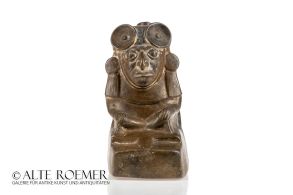 Mochica stirrup vessel as a shaman
Mochica stirrup vessel as a shamanImposing Peruvian vessel shaped like a priest on a podest with rich adornments. Circa 100 to 500 AD. With documents form the 1980ies.
Price: on request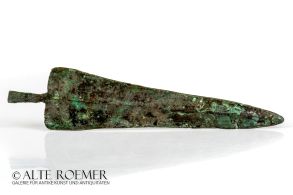 Luristan bronze dagger with tang
Luristan bronze dagger with tangDouble-edged blade of a short dagger from the Luristan region in Ancient Iran. An early type from the Middle Bronze Age.
Price: on request Iron Age spearhead from Sweden
Iron Age spearhead from SwedenWell-preserved iron weapon, a find from the Swedish province of Värmland. Acquired in 1894 into the collection of the Bally-Prior Museum.
Price: on request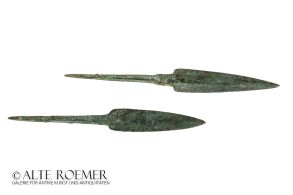 Two Near Eastern weapon points
Two Near Eastern weapon pointsGroup of two bronze points for small spears or large arrows from the Bronze or Early Iron Age. With a nice green patina.
Price: on request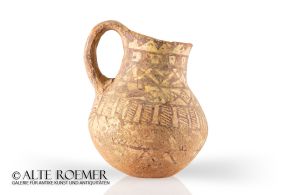 Painted Bronze Age jug
Painted Bronze Age jugThe clay jug is decorated by an impressively well preserved geometric design. From Bronze Age Anatolia.
Price: on request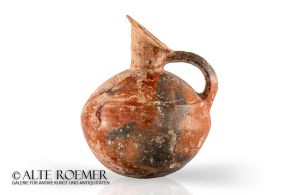 Spouted jug of the Yortan culture
Spouted jug of the Yortan cultureThe large jug has a spherical body, decorated with two stylized arms and hands. From Bronze Age Anatolia.
Price: on request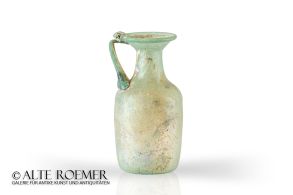 Roman glass bottle with handle
Roman glass bottle with handleNice and relatively large bottle from the late Roman imperial period. Probably from the Roman province Judaea.
Price: on request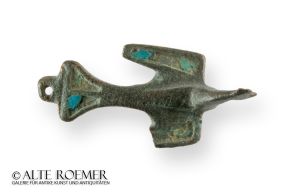 Flying bird brooch from Roman Britain
Flying bird brooch from Roman BritainA local British production from the 2nd century. It is taking up a continental brooch type. From the famous Hattatt collection and published in two standard works on ancient brooches.
Price: on request Roman rosette brooch from Colchester
Roman rosette brooch from ColchesterA nice brooch type from the 1st century with an especially well preserved decorative disc. From the famous Hattatt collection and published in two standard works on ancient brooches.
Price: on request Disc brooch from Roman Britain
Disc brooch from Roman BritainNicely enameled brooch with a Romano-Celtic sunburst design. From the 2nd century AD. Published in two stardard works on ancient brooches by Richard Hattatt.
Price: on request Three neolithic arrowheads from Egypt
Three neolithic arrowheads from EgyptThe Stone Age points are finely crafted. From a 100 year old museum collection.
Price: on request Three neolithic arrowheads from Egypt
Three neolithic arrowheads from EgyptThe Stone Age points are finely crafted. From a 100 year old museum collection.
Price: on request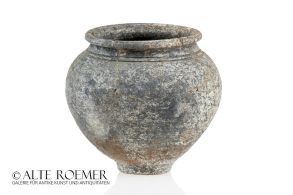 Römisches Töpfchen
Römisches TöpfchenGeborgen in den Jahren 1966 bis 1981 in Zusammenarbeit mit lokalen Archäologen. Neuss, das römische Novaesium, war eine frühe römische Gründung in der Provinz Germania Inferior und ist somit eine der ältesten Städte Deutschlands.
Price: on request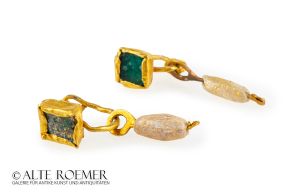 Pair of Roman gold earrings
Pair of Roman gold earringsThe earrings belong together originally. They are nicely decorated by beads and glass inserts. A beautiful pair of jewellery from the 3rd century.
Price: on request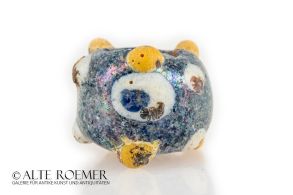 Phoenician eye bead
Phoenician eye beadPolychrome glass bead with stylized elements of a face as protection against the evil eye. Produced in Carthage or the Phoenician homeland, 4th to 3rd century BC.
Price: on request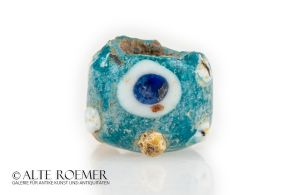 Phoenician eye bead
Phoenician eye beadPolychrome glass bead with stylized elements of a face as protection against the evil eye. Produced in Carthage or the Phoenician homeland, 4th to 3rd century BC.
Price: on request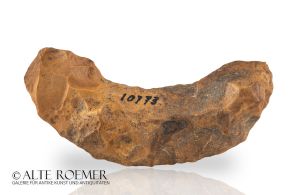 Stone Age bow scraper from Egypt
Stone Age bow scraper from EgyptThe Paleolithic tool is of beautiful shape and color. Thebes has been handed down as the place of origin. From an old museum collection.
Price: on request Paleolithic hand axe or borer
Paleolithic hand axe or borerPrehistoric stone tool. It was the universal tool of the older Stone age and could be used as a borer or chisel. From a Swiss museum collection. Found in the Algerian Sahara desert.
Price: on request Large prehistoric hand axe
Large prehistoric hand axeMassive Paleolithic stone tool. It was the universal tool of the older Stone age and could be used as a borer or a cutter. From a Swiss museum collection. Found in Algeria, North Africa.
Price: on request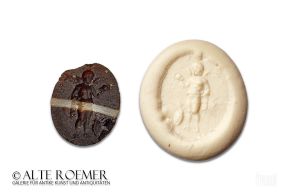 Roman intaglio with Eros as child god
Roman intaglio with Eros as child godThe Roman intaglio is made of banded glass paste. It show the god standing with a bowl in one hand. From the Professor Brosch collection of engraved gems.
Price: on request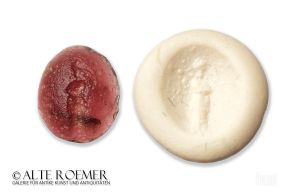 Roman intaglio made of beautiful glass paste
Roman intaglio made of beautiful glass pasteThe piece from the Professor Brosch collection shows a standing woman. Wonderful violet colour.
Price: on request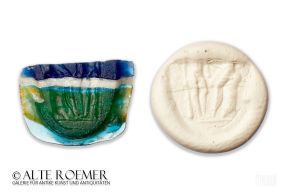 Roman intaglio with Heracles
Roman intaglio with HeraclesThe glass paste is of wonderful blue and green colour with a white band. It shows the young Heracles with his club.
Price: on request Trumpet brooch with Celtic decorations
Trumpet brooch with Celtic decorationsUnusual and rare variant of high importance, published several times. Beautiful silver inlays on the bow showing tendrils in Celtic style. From the 1st century.
Price: on request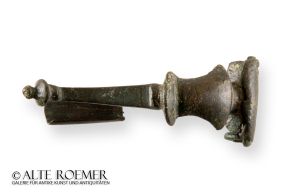 Roman Kraeftig Profilierte fibula
Roman Kraeftig Profilierte fibulaFibula with noble green patina. An import from mainland Europe to Roman Britain. From the 1st century AD. Published in two stardard works on ancient brooches by Richard Hattatt.
Price: on request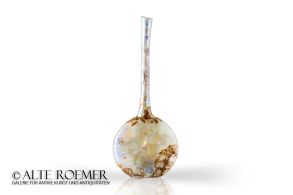 Roman lentoid glass flask
Roman lentoid glass flaskThe flat bottle has a discoid body with a very long neck. Probably from the Roman province Judaea.
Price: on request Victorian ink bottle
Victorian ink bottleThe vessel is made of beautiful, turquoise glass. From the collection of Moshe Dayan.
Price: on request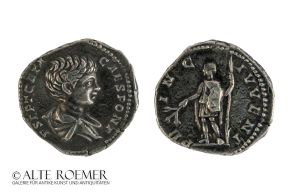 Extremely fine Geta denarius
Extremely fine Geta denariusThe obverse shows the emperor standing left in military attire, holding spear and branch. Wonderful dark patina
Price: on request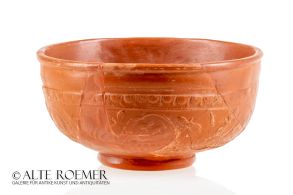 Terra Sigillata bowl from the Rhineland with hares and birds
Terra Sigillata bowl from the Rhineland with hares and birdsFound near the Roman city of Novaesium, today's Neuss in Germany, an early Roman foundation and with this one of the oldest cities in Germany.
Price: on request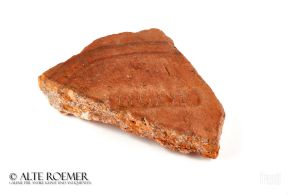 Roman legionary tile from the Rhineland
Roman legionary tile from the RhinelandLEG XVI (Gallica), 43 - 70 AD. Found 1966 till 1981 near the Roman city of Novaesium, today's Neuss in Germany. Novaesium was an early Roman foundation and with this is one of the oldest cities in Germany.
Price: on request

